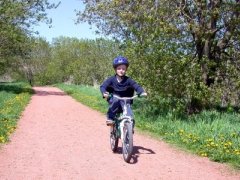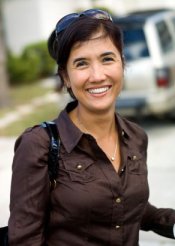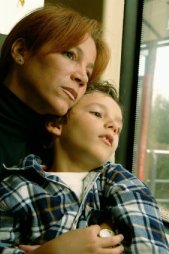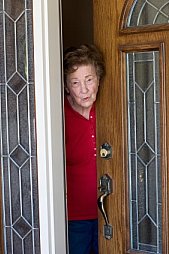Free-Range Kids
vs
Safe-Range Kids

Should parents actively supervise their kids’ play time?
Some parents follow the “free-range” way of more relaxed parenting – but the extremists among them (too relaxed) let their kids wander off alone to become more “self-sufficient” even though unsupervised kids are often too young to deal with potential hazards – especially when boredom and/or curiosity tempt them to try a dangerous stunt.
Other parents are more cautious – but the extremists among them are called “helicopter” parents (hyper-attentive "control-freaks") – always hovering over their kids, which may cause them to become “fragile” and overly dependent.
At what point does either type of parent become an extremist? Critics of over-parenting often ignore the harms of under-parenting – and vice versa.
Here's a tried-and-true middle ground:
“Safe-Range Kids” parenting is simply letting kids play freely (unstructured) within a designated area and with a designated, attentive adult nearby as a lifeguard. It's simply free play in a safe range. Enlarge the area over time after careful tutoring. Err on the side of caution to play it safe. (See the bottom of this page for links to tutorials as well as a list of common parenting styles.)
From One Extreme to the Other
Lenore Skenazy’s 2009 “FREE-Range kids” book urges parents to relax their kids’ supervision and allow them to roam freely to learn self-sufficiency.
She has useful tips to reduce over-parenting and rescue henpecked kids from extremist helicopter parents (the control-freaks). But, especially in her public statements, she often throws caution to the wind and goes to the other extreme of far too much freedom and dismisses those who disagree with her as irrational or paranoid. Let’s see if her book can withstand rational scrutiny.
A Thumbnail History
A popular narrative claims that, starting in the 1970s, the media hyped the increasing rate of crimes against children, which resulted in overreaction and overprotection, and that contributed to stunted childhood development which, in turn, supposedly caused 21 percent of modern college students to become "anxious and depressed."
At first, in 2009, the media ridiculed Ms. Skenazy’s free-range theory, calling her “America’s Worst Mom.” She used that label as publicity leverage to sell her book and even get her own short-lived cable-TV show – and ever since has been trying to justify her flimsy theory.
Yet as more research emerged showing the growing problem with some college students’ self-sufficiency, some parents began adding more unstructured free play to enrich childhood development – and some of them went too far and became free-range extremists.
But extreme free-range wandering (unsupervised) needs to be pulled back to 'free play in a safe range' by always having a designated, attentive adult nearby as a lifeguard. That way, kids still get the developmental benefits of unstructured free play and lessen the significant risks of P.A.D.D. – predators, accidents, delinquency, and drugs. (The stats are below.)
Zero Tolerance vs Hazy Guidance
Most U.S. state laws define child endangerment as “placing a child in a potentially harmful situation through negligence or misconduct.” Penalties range from a misdemeanor to a felony.
It’s difficult to exactly define ‘child endangerment’ or ‘negligence.’ As a result, most state legislatures enact strict parameters with zero tolerance and have a judge determine each case individually. But such inflexible laws are sometimes unfairly rigid and treat some parents unjustly.
In May 2018, the state of Utah enacted Child Neglect Amendments to their law and redefined “neglect” to exclude things like letting a lone child walk to school or play in a park – with this hazy clause: “of sufficient age and maturity to avoid harm or unreasonable risk of harm.”
Utah now leaves it to Child Protective Services to decide each case on its own merits and give (mildly errant) parents a fair warning – thereby likely sparing them from legal proceedings.
Ms. Skenazy spearheaded the drive for the amendments, which some media call the “free-range parenting law.” But what does such a vague term mean?
And how do parents know exactly what is “of sufficient age and maturity?” Is that just a matter of opinion? Whose opinion? What are the standards, the criteria? The new law needs to be more specific – it's just as vague as the law it amended. However, it does spare mildly errant parents from going to court. But calling it the “free-range parenting law” is much hype over not much.
“Nothing takes the place of parental or trusted adult supervision and attention,” says Nancy McBride, director of prevention education at the National Center for Missing and Exploited Children. “Obviously, that's true for younger children, but it's just as true for older children. There's no book, no video, no gimmick you can buy that can take the place of that.”
► The Children of Pornhub shows how the world's largest porn-site traps unsupervised teens. And it's just one of many dangers.
The Gift of Fear
Ms. Skenazy portrays cautious parents as ‘living in fear’ as though they’re paranoid instead of realistic people with legitimate concerns. In fact, behaving cautiously is what practical people must do every day, such as using seat-belts, driving safely, locking their home's doors, and so on - in all, recognizing and avoiding dangerous situations.
The ‘Precautionary Principle’ of risk management says that potential risks, no matter how remote, must be given more weight than any presumed benefit. It’s better to overestimate rather than underestimate any possible harm. And when it comes to your precious kids, it’s better to play it safe.
Calm, commonsensical fear and wariness are essential, everyday survival traits that have kept us alive throughout history. Fear and caution protect us. Read “The Gift of Fear” as well as "Protecting the Gift - Keeping Children and Teenagers Safe" by renowned security expert Gavin de Becker.
The Pollyanna Syndrome Muddies The Waters
The Pollyanna Syndrome (the “it-couldn’t-happen-to-me” attitude) is derived from the 1913 novel “Pollyanna” about an excessively optimistic girl. That’s what psychologists call the tendency for many people to recall pleasant memories more easily than unpleasant ones – looking back at the ‘good old days’ through rose-colored glasses and seeing ‘anecdotal fallacies.’ (The Pollyanna Syndrome is also known as “rosy retrospection” or “nostalgia bias.”)
Part of the parenting controversy is that parents like Ms. Skenazy often deceive themselves with anecdotal fallacies that project their experience, or that of people they know, onto the general (and diverse) population, such as: “My childhood was (fill-in-the-blank) and I’m OK, so it must be OK for everyone.” Ms. Skenazy's book is chock-full of anecdotal fallacies that support her illogical theory.
But all childhood memories and anecdotes are subjective and reciting them as some sort of universal wisdom makes it impossible to have an objective discussion. Please, let's dump the clutter and stick to the facts:
Predators Are Always Among Us
The USDOJ says between 750,000 and 1.3 million children are reported missing each year. Roughly 140,000-240,000 of those are temporarily lost or runaways, and 500,000-900,000 are kidnapped in a parental custody dispute.
Every year on average, 50-100 kidnapped children are murdered, and another 50-100 are offered for ransom or disappear permanently. Another 58,000 are briefly abducted or lured away. And yet another estimated 150,000 children are targeted but escape by rejecting a lure and escaping.
Ms. Skenazy disregards the total of 100-200 deaths/disappearances every year because they’re so few compared to the millions of kids in the U.S. She also plays down the 58,000 briefly kidnapped and doesn’t even mention the 150,000 children targeted by predators (but escaped capture). How could she close her eyes to more than 200,000 kids targeted every year?
From 1981 to 2015, more than 1,000 children went missing and were never found - dead or alive. And nearly 2 million other kids were briefly kidnapped but survived.
The vast majority of strangers will protect a child - IF they happen to notice that the child is in danger – see Stranger Danger vs Stranger Safety FAQ Also know that three percent of men are devious pedophiles. That means 1 man in 33 craves sex with a child. Why tempt him with your unsupervised child?
Crimes Against Children
Three Types of Child Molesters - A 2001 University of Pennsylvania study found that 47 percent of child molesters were relatives; 49 percent acquaintances, such as a teacher, etc.; and 4 percent were strangers. The molesters were 91 percent male – a quarter of them married with children.
Child Safety - Molesters shows how 'acquaintance' molesters target kids.
Child Safety - Kidnapping Escape shows social-media lures into sexploitation and worse. See complete Internet Safety For Kids & Parents - FAQ . Also see Common Kidnapping Lures at Child Safety - Outdoors
Children must be mature enough to reject any lure to isolate them – whether outdoors or home alone with a stranger at the door (see Push-In and Scam-In).
The rate of crimes against children is lower today than in the past, so now Ms. Skenazy wants to decrease the tighter parental supervision that was crucial in reducing those crime rates. Now that's irrational.
Accidental Injury of Children
Unintentional (accidental) injuries of children and teens 0-19 years caused 12,175 deaths and 9.2 million nonfatal injuries (hospitalized). Motor vehicle injuries were highest in teens 15-19 years old. Source: CDC 2008 Child Injury Data
Not surprisingly, most motor vehicle injuries of teenagers occur when unsupervised teenagers are driving (that's why car insurance rates are so high for teenage drivers ). This disproves the contorted (self-serving) stats on page 184 of the 'Free-Range kids' book that somehow compare child kidnappings to car crashes. It's absurd to compare little kids to 15-19 year old teenagers in completely unrelated situations. That's comparing apples to watermelons.
She also illogically compares other (accidental) injuries to the few child kidnapping/murders – while ignoring the far more numerous attempted kidnappings and brief kidnappings wherein the kids survived. Again, why is she blind to more than 200,000 children targeted by predators annually?
On top of that, Ms. Skenazy unwittingly destroys her own theory because when she says that child kidnapping/murders are far outnumbered by car-crashes, fires, and drownings, etc., she's actually proving that your child does indeed need even closer adult supervision to help prevent all those accidents! DOH!
And that is the exact opposite of her unsupervised free-range theory. Close examination of her garbled, self-serving statistics exposes her illogical reasoning - as you'll see throughout this page.
The U.S. CDC says:
• Every 4 seconds, a child is treated for an injury in a hospital.
• Every hour, 1 child dies from an injury.
• About 1 in 5 child deaths is due to injury.
Source: CDC Child Injury April 2012 - “Injuries of children 0-19 years are preventable. Car crashes, suffocation, drowning, poisoning, fires, and falls are the most common ways children are hurt or killed. More can be done to keep our children safe.” So says the CDC (contrary to free-range theory).
The Child Safety Guide has more from the CDC:
►Unintentional injuries are the leading cause of death among children and teens in the United States.
►Emergency departments treated more than 4.1 million children and teens for accidental injuries in 2020.
►More than 7,000 children and teens died from unintentional injuries in 2019.
Although perfect safety is an impossible goal, you can significantly reduce childhood injury risks by following basic child safety practices.
How to Teach Children About Risk – lessons in the rational appraisal of danger.
Not Telling Your Kids vs Playing It Safe
In The Straits Times - August 1, 2015 newspaper interview Lenore Skenazy said: “If parents tell children something is too dangerous, they are telling their children who they are and who they can be, before they have even tried it.”
Isn’t that awfully hazy, Ms. Skenazy – in fact, irrational? So do not tell little Johnny that it’s too dangerous to tease a rattlesnake. Let him find out on his own and learn who he is and who he can be (whatever that means - and IF he survives).
Ms. Skenazy told ABC News on May 08, 2018 that “There's no right way to parent,” she said. “You have to give the parent leeway because they know best…” Huh? Does she really think that all parents “know best?” Then why does she always bash “helicopter” parents - or any parent who disagrees with her? Why don't they "know best?" Her loopy logic contradicts itself.
She claims that only unsupervised free-range wandering with random kids will somehow magically teach children to be “resilient” and “self-sufficient.”
Some professors actually agree with her yet they, too, don’t realize that kids can have unstructured, free play in a safe-range with an adult lifeguard nearby. They’re also blissfully unaware of her many other flaws exposed on this page. Are any professors ever wrong? Will you bet your child on them?
Kids need a lifeguard whether they're in water or on dry land. Regardless of what a few professors say, it's simply common sense - and confirmed by the CDC statement (mentioned above): “More can be done to keep our children safe.”
Free-Range Kids Gone Astray
When kids aren't supervised or monitored, a power hierarchy sometimes develops as group-think and peer pressure lead them into deviant behavior and doing stupid things simply to maintain bonds with their peers. Why risk your kids hanging out with ‘the wrong crowd’ and having ‘problem’ kids lead them astray?
There are also older kids as well as adult predators who lure unsupervised teens with alcohol and/or drugs.
The CDC reported 70,237 drug overdose deaths in 2017 – that's 191 deaths every day in the U.S. alone! There are also many more drug addicts ruining their lives. Add those stats to the Prison Policy Initiative that says, in 2014, 2.4 million prisoners were in federal or state prisons and county jails (for all types of crime).
Where do all these criminals and addicts – these wayward kids now grown – come from? Does anyone really think that more than a small fraction of them were raised by helicopter parents?
Almost all juvenile delinquents and gang members, most drug addicts, and most prison inmates were raised as extremist free-range kids (defined by default) who were not carefully supervised throughout their youth. It's blatantly self-evident and speaks for itself.
[But to be clear, most well-trained, moderately free-range kids do not go astray – rather mostly just those raised by extremist free-range parents (or highly-stressed parents struggling with overwhelming life burdens).]
Marketing vs Reality
“FREE-RANGE kids” (as it appears on the book's cover) is a rousing and catchy title for marketing and publicity purposes. The cover is enhanced with the image of distant trees, a heavenly blue sky, and a lone child dressed as an explorer, focusing on a map, seemingly on an exciting adventure. Go, kid, go!
The fanciful cover and the fuzzy meaning of the title urge parents to let their kids range freely and boldly on their own. However, that would endanger the millions of kids whose surroundings are not safe for aimless, unsupervised wandering. And while there are some helpful tips for less rigid parenting, the old saying holds true: "You can't judge a book by its cover." This book’s content comes nowhere near the fantasy that the cover sells.
Overall, her guidelines brush aside the dangers of predators, ignore accidents, and also gloss over the risks of delinquency and drugs (with just one brief mention on page 187). In effect, Ms. Skenazy conceals the annual toll of:
• 200,000+ unsupervised children targeted by predators
• 12,000+ accidental child deaths
• 9 million+ hospitalized accidental child injuries
• 70,000+ drug overdose deaths (and many more are addicts)
• 2 million+ prison inmates
Is she a blindly optimistic Pollyanna ignoring inconvenient truths – seeing only what she wants to see? How could she miss the glaring downside of her unsupervised free-range theory that puts millions of kids at risk of P.A.D.D. – predators, accidents, delinquency, and drugs? Why is she opposed to lifeguards? Lenore Skenazy is a modern-day Donna Quixote crusading to save kids from safety.
The ill-conceived free-range theory needs to be replaced with the far more sensible ‘Free Play in a Safe Range’ - with an adult lifeguard nearby.
What? Now Even 'Let Grow' Has Lifeguards!
Ms. Skenazy's new program, 'Let Grow' (with the self-aggrandizing motto of “Future-proofing Our Kids and Our Country”), urges schools to add 'Play Club'
free-play periods in the playground or gym before and/or after school – WITH an adult nearby as a 'lifeguard.’ Whoa! An adult lifeguard? That blatantly contradicts her book's free-range theory - without a lifeguard!
Instead, 'Let Grow' is actually 'Free Play in a Safe Range' - with a designated, attentive adult lifeguard nearby. Is Ms. Skenazy now disavowing the fanciful Free-Range claims of her book? She doesn't realize that massive self-contradiction (or won't admit her past foolishness) even as late as 2025.
Let's hope that Let Grow will someday also recommend 'Free Play in a Safe Range' with a lifeguard for your child outside of school as well – and drop the Free-Range nonsense.
A Balanced Middle Ground for Safe-Range Kids
• Learn your state's laws. As to “sufficient age and maturity,” err on the side of caution – play it safe. Make sure your local laws agree with this article: At What Age Can Kids Go Out By Themselves?
• Take your child to inspect the area or route where s/he's allowed to go – preferably not alone – and also avoid lonely areas. A designated free-play area or route is safest when it’s near a designated, attentive, adult lifeguard (within earshot).
• A child needs a lifeguard nearby when on dry land and especially when in water. Drowning is NOT easy to spot - and can happen very quickly. Rescuing is not easy, either. See How to Spot a Drowning Swimmer . Also see 3 Non-Obvious Signs of Drowning That Every Adult Should Know.
• Grant them more freedom only after more step-by-step tutoring.
• Monitor ‘problematic’ playmates who can negatively influence your child – even well-behaved youngsters can become cleverly devious teenagers.
• A personal alarm (a.k.a. screamer or noisemaker) can be useful when a child is taught to use it properly. Attach it to a waist-belt so the child won’t drop it as s/he runs away – a predator will be less likely to chase after a noisy target. [Caution - to be used with the utmost parental discretion, supervision, and attention.]
• Pepper spray is only for a trained child when going to places where pepper spray is not prohibited for kids. Remember that kids are not allowed to have pepper spray on school grounds. Check your local and state laws. [Caution: to be used with the utmost parental discretion, supervision, and attention.]
• The RadKids.org teaches self defense (from bullies, molesters, kidnappers) as well as all-around safety lessons for ages 5-12.
• There are also many extracurricular activities at schools and community organizations. The Society for Research in Child Development says extracurriculars for kids provide many benefits, including higher grades and self-esteem.
• The newly-reorganized Scouts BSA for both boys and girls age 11-17 years old provides many benefits (as do their Cub Scouts for kids all the way up to Eagle Scouts).
• Training in martial arts is an excellent education for children. It gives them strength, endurance, agility, balance, eye-hand coordination, and flexibility. It also instills character, courtesy, discipline, self-control, self-esteem, respect for elders, a gratifying sense of accomplishment and pride, as well as resiliency and self-sufficiency. And last but not least, martial arts provide lifelong skills for defending themselves from bullies and predators. See Choosing a Self-Defense Class
Stranger Danger FAQ
Child Safety - Outdoors
Child Safety - Molesters
GPS Child Locator
Netsmartz
Kidsmartz
National Center for Missing and Exploited Children
Common Parenting Styles
Basic parenting categories used by family psychologists:
• Authoritarian = strict (maybe even harsh) overseer.
• Authoritative = loving overseer.
• Permissive = carefree (careless?) overseer.
Child development experts say the authoritative parenting style is the most successful in raising children who are both academically strong and emotionally stable.
Here are just a few of the informal parenting categories used by the parenting industrial complex:
• Attachment (Pampering/Authoritative) = often accused of overindulging and “bubble wrapping” the child.
• Snowplow, Bulldozer, or Lawn-Mower (Indulgent/Authoritative) = make sure their kids never face any obstacles in life.
• Helicopter (Authoritarian) = very involved (to varying degrees). They're also known as: Anxious, Attentive, Concerted Cultivation, Defensive, Hands-On, Hyper, Intensive, or Over-parenting. The extremists are considered “control freaks.”
• Wabi Sabi (Authoritative/a mixed, Japanese style) = relaxed, accepting.
• Tiger (Authoritarian) = strict, encouraging.
• Elephant (mild Authoritarian) = somewhat less strict, more nurturing.
• Elk (Permissive) = laissez-faire, lax, lazy.
• Bison (Authoritative) = lovingly and attentively protective.
• Dolphin (Authoritative) = balanced, middle-of-the-road parenting
• Jellyfish (Permissive) = no boundaries, expectations, guidelines, or goals (irresponsible parenting).
• Free-Range (Authoritative/Permissive) = carefree, relaxed, risky if too free and unsupervised. See more of Ms. Skenazy's irrational "logic" at Why I Broke Up with Lenore Skenazy and Free Range Kids
• Safe-Range (Authoritative) = encourages independence, resilience, and self-sufficiency in school and at play – with a designated, attentive adult lifeguard nearby. Most of the above styles blend well with 'free play in a Safe Range.'
See more links on Child Safety - Overview.
Crime-Safety-Security > Child Safety Overview > Free-Range Kids









